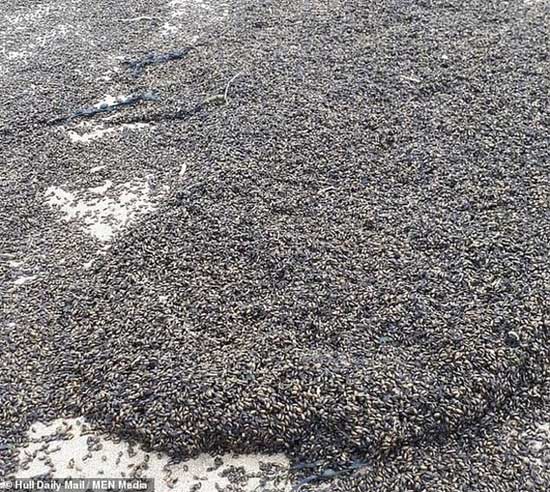'Horrified' at the sight of millions of black covered insects on the beach
Unusual spectacle rarely happened, so the witnesses shuddered.
The beetles Europe appears an unusual and mysterious, covered on the beach in Cayton Bay, near Scarborough, England, Tuesday 13/4.
A local resident named Sue Weatherill when walking around the beach early in the morning discovered it. It is estimated that the number of bugs can reach millions.

The beach is pitch black, covered with millions of beetles.
According to Sue, while walking along the coast, she accidentally discovered something strange lying black on the beach like "seed pod". When approached, the startled woman noticed that they were beetles. "This has never been here before. I was even more shocked to realize they were living creatures , " Sue said.

This anomaly has never happened.
Some people speculate that this insect may be Lochmaea suturalis , a native species of bugs living in northwestern Europe. However, according to the staff of the Coast Guard team Scarborough and Burniston (SBCR), this is the European chafer beetle.

Close up of beetles on the beach.
"On the afternoon of April 13, when the team was patrolling the beach, one member reported an abnormality. A large number of European chafer beetles had washed up on the coast around the beach. has notified the coastal pollution treatment team for further investigation , " said the representative of the SBCR rescue team.

The reason that millions of bugs suddenly appear on the UK coast is still under investigation.
The European chafer beetle belongs to the Scarabaeidae family, usually a light reddish-brown color with an average length of 13-14 mm. In the past, they used to appear only in Europe, but now have spread to parts of North America, often eating leaves.
- Video: "Beetle" beetles fight over territory
- The beetle's vivid colors may affect the future of light technology
- The Argentine typhoon sealed the end of the world?
- The scene is like an apocalypse in America when millions of bugs invade the city!
- Indian beaches are covered with white foam due to pollution
- Surreal scenes such as aliens at the 'dragon egg' rock beach tens of millions of years old
- Dead black dolphin washed up on Cat Hai beach
- Millions of black holes are hiding in our galaxy
- How do insects keep their bodies warm?
- 15 great things are only available in the island of Iceland
- Millions of moths surround the village in Australia
- Controversy about the photo of the couple hugging each other on the beach
- Video: Sea shells thousands of children cover the US beach
- Sparkling frost-covered insects
 Why do potatoes have eyes?
Why do potatoes have eyes? 'Tragedy' the world's largest carnivorous life: Death becomes ... public toilet
'Tragedy' the world's largest carnivorous life: Death becomes ... public toilet Tomatoes were once considered 'poisonous' for 200 years
Tomatoes were once considered 'poisonous' for 200 years Detecting microscopic parasites on human face
Detecting microscopic parasites on human face Britain's failed explosive car invention
Britain's failed explosive car invention  The most 'weird' sea in the world, only 1 person bathes at a time, but customers are still lining up
The most 'weird' sea in the world, only 1 person bathes at a time, but customers are still lining up  13 beaches with the most beautiful scenery in the world
13 beaches with the most beautiful scenery in the world  Burial whales bloody red bubbles
Burial whales bloody red bubbles  People in the Mexican sea are startled by the unique phenomenon
People in the Mexican sea are startled by the unique phenomenon  The color-changing rocky beach has a million-year history in China
The color-changing rocky beach has a million-year history in China 